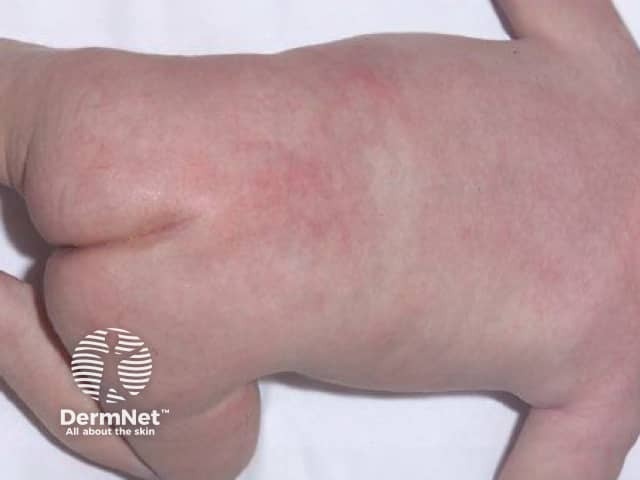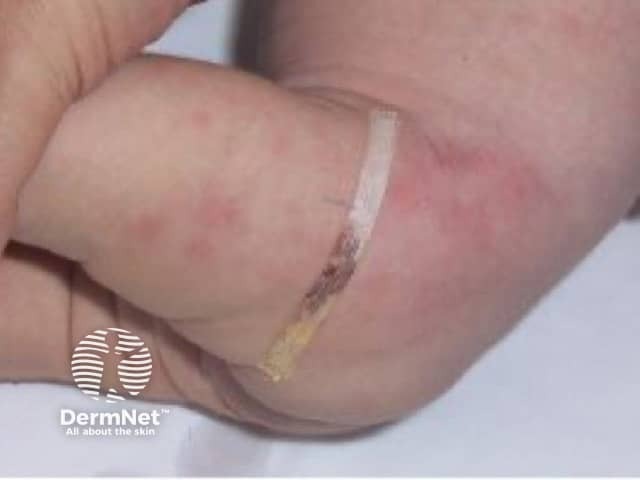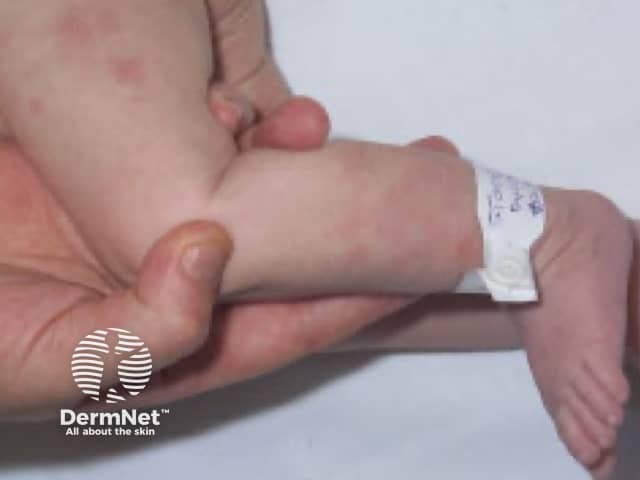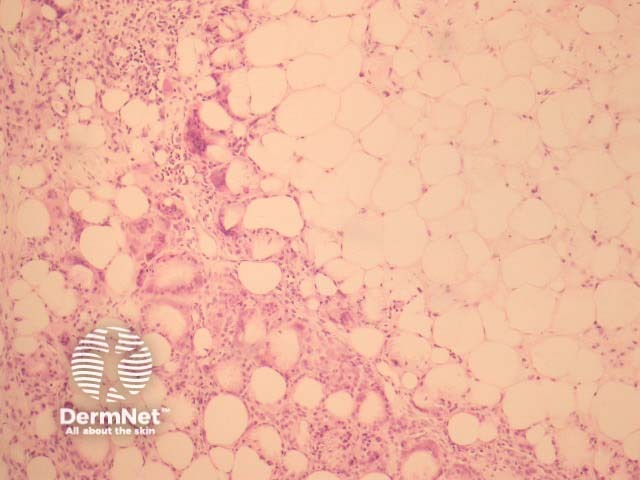Main menu
Common skin conditions

NEWS
Join DermNet PRO
Read more
Quick links
Subcutaneous fat necrosis of the newborn — extra information
Subcutaneous fat necrosis of the newborn
Last Reviewed: January, 2025
Author: Dr Stanley Leong, Dermatology and Paediatric Registrar, Christchurch Hospital, NZ (2025)
Peer reviewed by: Dr Jemima Sellicks, Leicester Royal Infirmary, United Kingdom (2025)
Reviewed dermatologist: Dr Ian Coulson
Edited by the DermNet Content Department
Introduction
Demographics
Causes
Clinical features
Variation in skin types
Complications
Diagnosis
Differential diagnoses
Treatment
Outcome
What is subcutaneous fat necrosis of the newborn?
Subcutaneous fat necrosis of the newborn (SCFN) is a rare, self-limiting panniculitis that usually appears as firm, inflamed skin-coloured to purple nodules (lumps) in the first few days of life. Lesions most commonly appear on the thighs, buttocks, cheeks, back, and arms.

Indurated plaques on the back of a newborn due to SCFN

Indurated red plaques over the hips and thighs due to SCFN

SCFN on the legs
Who gets subcutaneous fat necrosis of the newborn?
SCFN is most common in term and postterm newborns, however, some cases have been described in premature neonates. Cases tend to be observed within the first 4 weeks of life.
What causes subcutaneous fat necrosis of the newborn?
The pathophysiology of SCFN is unclear but it is thought to mainly affect the brown fat, which is high in saturated fatty acids and has a role in heat generation in response to cold exposure. Under stress, tissue hypoxia with impaired perfusion leads to the crystallisation of subcutaneous fat tissues, resulting in tissue necrosis and clinical features of SCFN of the newborn.
Predisposing risk factors:
- Low body temperature (hypothermia)
- Low oxygen levels (hypoxia and birth asphyxia)
- Large birth weight (large for gestation age)
- Meconium aspiration
- Therapeutic hypothermia (whole body cooling)
- Caesarean section
- Obstetric trauma (e.g. forceps delivery)
- Maternal diabetes
- Maternal hypertension (pre-eclampsia)
- Maternal hypothyroidism
- Placental abruption
- Infection
It is important to be aware that most neonates who are exposed to the above factors do not get SCFN.
What are the clinical features of subcutaneous fat necrosis of the newborn?
Tender, firm, rubbery, red nodules typically appear on the back, buttocks, shoulders, cheeks, and extremities. Nodules size can range from singular lesions 1cm to multiple lesions >8cm in diameter. In some instances, particularly on the back and buttocks, broad areas of fat necrosis can occur and manifest as large plaques.
Nodules may be woody hard on palpation and as they progress may develop a brown colour. Larger nodules may become fluctuant in nature. Patients are often afebrile and without systemic symptoms.
SCFN of the newborn is less severe than sclerema neonatorum, which is another condition that may cause hardened skin in newborns.
How do clinical features vary in differing types of skin?
Subcutaneous fat necrosis of the newborn can manifest as darkened/pigmented nodules or plaques rather than erythematous appearance.
What are the complications of subcutaneous fat necrosis of the newborn?
The nodules of subcutaneous fat necrosis of the newborn are often painful and in rare cases may last for months before resolving. Occasionally, the infant may be left with a dimpled area of reduced fat.
Hypercalcemia is a rare but serious complication of SCFN. This is due to increased prostaglandin activity, released calcium from necrotic fat, raised macrophage secretion of 1,2-dihydroxycolecalciferol, and decreased renal calcium clearance. All babies with subcutaneous necrosis of the newborn should have blood calcium checked periodically for the first few months of life.
Signs and symptoms of hypercalcemia include:
- Lethargy
- Hypotonia
- Irritability
- Constipation
- Vomiting
- Frequent urination
- Frequent thirst
- Poor weight gain
- Arrhythmia (very rarely).
Subcutaneous fat necrosis of the newborn has been associated with long-term thrombocytopenia. Infrequently, infants may also exhibit thrombocytosis. Anaemia, low blood sugar level (hypoglycaemia), and raised levels of fat in the blood (hyperlipidaemia) have also been observed.
In most cases, these laboratory abnormalities occur early in the disease course and are mild and transient.
How is subcutaneous fat necrosis of the newborn diagnosed?
Subcutaneous fat necrosis of the newborn is usually diagnosed clinically. Biopsy of skin can be performed to confirm the diagnosis.
Histopathology findings include:
- Lobular panniculitis with mostly histiocytic infiltrate, including multinucleated giant cells and adipocytes
- Needle-shaped clefts (intracellular crystals from triglycerides) in the histiocytes as well as adipocytes
- Foamy histiocytes
- Fat necrosis with granulomatous inflammation
- Calcification may be present

There is a lobular panniculitis and giant cells can be seen in the fat
Ultrasound can be used to confirm the diagnosis, and does not require sedation or the use of ionising radiation.
What is the differential diagnosis for subcutaneous fat necrosis of the newborn?
- Traumatic panniculitis.
- Cold panniculitis: This usually manifests as firm, well-demarcated, erythematous plaques at sites where the skin has been in direct contact with cold objects.
- Sclerema neonatorum: This is an extremely rare panniculitis that affects critically ill preterm or low birth weight neonates and is associated with high mortality rate. This condition usually appears in the first days after birth. The skin is often tightened symmetrically and may tether to underlying tissues. The skin eruption usually spreads quickly to involve all skin with underlying fat but spares genitalia, palms and soles which lack subcutaneous fat. Histopathology shows similar finding as subcutaneous fat necrosis of the newborn but lack of inflammatory cell infiltrates.
- Scleroedema (scleredema): This is a rare condition that develops in newborns exposed to cold environments or severe infection during the first week of life. Affected skin tends to be thickened, wax-like, and oedematous. Scleroedema usually affects the legs. Infantile scleroedema must be distinguished from adult scleroedema.
- Steroid withdrawal: This can lead to subcutaneous nodules, usually on the cheeks, arms, and trunk.
What is the treatment for subcutaneous fat necrosis of the newborn?
SCFN is generally self-limiting and management should focus on symptom control. The inflammation often settles without specific treatment. If severe, systemic corticosteroids can be used to control the inflammation.
Hypercalcaemia secondary to subcutaneous fat necrosis of the newborn may require treatment such as increasing fluid intake, low calcium milk feeds, furosemide, corticosteroids, and bisphosphonates. Monitoring of blood calcium levels (for at least 4 months) is recommended.
What is the outcome for subcutaneous fat necrosis of the newborn?
The prognosis is usually favourable and treatment is unnecessary.
Bibliography
- Aucharaz KS, Baker EL, Millman GC, Ball RJ. Neonatal subcutaneous fat necrosis with characteristic rash and hypercalcaemia. Arch Dis Child Fetal Neonatal Ed. 2007 Jul;92(4):F304. PubMed ID: 17585095. Journal
- Elmoghanni Y, Aldhafer A, Khalaf M, et al. (February 01, 2023) Subcutaneous Fat Necrosis of the Newborn After Whole-Body Cooling for Birth Asphyxia. Cureus 15(2): e34521. doi:10.7759/cureus.34521. Journal
- Mahé E, N, Girszyn S, Hadj-Rabia C, Bodemer D, Hamel-Teillac D, De Prost Y. Br J Dermatol. 2007 Apr;156(4):709–15. doi: 10.1111/j.1365-2133.2007.07782.x. PubMed ID: 17493069. Journal
- Sahni M, Patel P, Muthukumar A. Severe Thrombocytosis in a Newborn with Subcutaneous Fat Necrosis and Maternal Chorioamnionitis. Case Rep Hematol. 2020 Feb 21;2020:5742394. doi: 10.1155/2020/5742394. PMID: 32148979; PMCID: PMC7056997. Journal
- Schulzke S, Buchner S, Fahnenstich H. Subcutaneous fat necrosis of the newborn. Swiss Med Wkly. 2005 Feb 19;135(7-8):122-3. PubMed ID: 15832229. Journal
On DermNet
Other websites
-
Subcutaneous fat necrosis of the newborn — The Australasian College of Dermatologists
